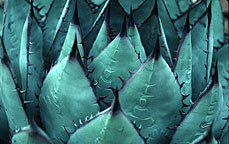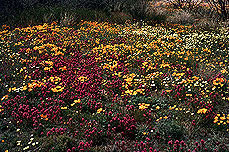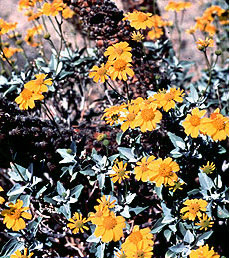from sonorensis, Volume 17, Number 1 (Spring 1997)
 Mark A. Dimmitt
Mark A. DimmittDirector of Natural History
Arizona-Sonora Desert Museum
Desert plants tend to look very different from plants native to other regions. They are often swollen, spiny, and have tiny leaves that are rarely bright green. Their strange appearance is a result of their remarkable adaptations to the challenges of the desert climate. Aridity is the sole factor that defines a desert and is the primary limitation to which desert organisms must adapt.
Desert plants have developed three main adaptive strategies: succulence, drought tolerance and drought avoidance. Each of these is a different but effective suite of adaptations for prospering under conditions that would kill plants from other regions.
Succulence
Succulent plants store water in fleshy leaves, stems or roots. All cacti are succulents, as are such non-cactus desert dwellers as agave, aloe, elephant trees, and many euphorbias. Several other adaptations are essential for the water storing habit to be effective.
 A succulent must be able to absorb large quantities of water in short periods.Desert rains are often light and brief, and the soil dries rapidly under an intense sun. To cope with these conditions, nearly all succulents have extensive, shallow root systems. The roots of a saguaro extend horizontally about as far as the plant is tall but are rarely more than four inches (10 cm) deep. The water-absorbing roots are mostly within the upper half inch (1.3 cm).
A succulent must be able to absorb large quantities of water in short periods.Desert rains are often light and brief, and the soil dries rapidly under an intense sun. To cope with these conditions, nearly all succulents have extensive, shallow root systems. The roots of a saguaro extend horizontally about as far as the plant is tall but are rarely more than four inches (10 cm) deep. The water-absorbing roots are mostly within the upper half inch (1.3 cm).
Succulents must be able to maintain their water hoards in a desiccating environment and use it as efficiently as possible. The stems and leaves of most species have waxy cuticles that render them nearly waterproof when the stomates are closed. Water is further conserved by reduced surface areas; most succulents have few leaves (agaves), no leaves (most cacti), or leaves that are deciduous in dry seasons (elephant trees, ocotillos, boojums).
Many succulents, as well as semisucculents such as most yuccas, epiphytic orchids, and xerophytic bromeliads, possess a water-efficient variant of photosynthesis called CAM, an acronym for Crassulacean Acid Metabolism. CAM plants open their stomates for gas exchange at night and store carbon dioxide. By day, while the stomates are closed, photosynthesis is conducted using the stored carbon dioxide. Because of the lower temperatures and higher humidity at night, CAM plants lose one-tenth as much water per unit of carbohydrate synthesized as standard C3 plants.
Another valuable attribute of CAM plants is their capability for idling metabolism during droughts. When CAM plants become water-stressed, the stomates remain closed both day and night; gas exchange and water loss nearly cease. The plant, however, maintains a low level of metabolism in the still-moist tissues. Just as an idling engine can rev up to full speed more quickly than a cold one, an idling CAM plant can resume full growth in 24 to 48 hours after a rain. Therefore, succulents can take rapid advantage of ephemeral surface moisture.
Stored water in an arid environment requires protection from thirsty animals. Most succulent plants are spiny or toxic, often both. Some protect themselves by growing only in inaccessible locations. Still others rely on camouflage. Arizona night blooming cereus, for example, closely resembles the dry stems of the shrubs in which it grows.
Drought Tolerance
Drought tolerance (or drought dormancy) refers to a plant's ability to withstand desiccation without dying. Plants in this category often shed leaves during dry periods and enter a deep dormancy. Most water loss is from transpiration through leaf surfaces, so dropping leaves conserves water in the stems. Some plants that do not normally shed their leaves have resinous coatings that retard water loss (e.g., creosote bush).
The roots of drought tolerant shrubs and trees are extensive compared to those of plants in wetter climates, covering an area up to twice the diameter of the canopy. They exploit the soil at greater depth than the roots of succulents; sometimes they extend to extreme depths (e.g., mesquite). Most of a mesquite's roots, however, are within three feet (0.9 m) of the surface.
Rooting depth controls opportunities for growth cycles. In contrast to the succulents' shallow-rooted strategy, a substantial rain is required to wet the deeper root zone of shrubs and trees. After a soaking rain has fallen, shrubs such as brittlebush and creosote take a few weeks to resume full growth from deep dormancy. The tradeoff between this strategy and that of succulents is that once the deeper soil is wetted by several rains it stays moist much longer than the surface layer, supporting several weeks of growth.
Succulents can absorb water only when the soil is nearly saturated. In contrast drought tolerant plants can absorb water from soil that is much drier. Similarly these plants can photosynthesize with low leaf moisture contents that would prove fatal to most plants.
 Drought Avoidance
Drought Avoidance
Annual plants escape unfavorable conditions by not existing. They mature in a single season, then die after channeling all of their life energy into producing seeds instead of reserving some for continued survival.
Most Sonoran Desert annuals will germinate only during a narrow window in the fall, after summer heat has waned and before winter cold arrives. During this window of opportunity there must be a soaking rain of at least one inch for most species. This combination of requirements is survival insurance: an inch of rain in the mild weather of fall will provide enough soil moisture that the germinating seeds will probably mature and produce seeds even if almost no more rain falls in that season. There is still further insurance: even under the best conditions not all of the seeds will germinate; some remain dormant. Although the mechanisms are not known, a percentage of any year's crop of desert lupine seeds will not germinate until they are ten years old.
Seedlings rapidly produce rosettes of leaves during the mild fall weather, remain flat against the ground as they grow more slowly through the winter, and bolt into flower in the spring. Since the plants are inconspicuous until they begin the spring bolt, many people mistakenly think that spring rains produce our wildflower displays.
Annuals are common only in communities that have dry seasons, where the spacing of perennial plants is determined by the rooting space required to obtain enough moisture to survive the driest years. In the occasional wetter years both open space and moisture are available to be exploited by a population of fast-growing annuals. The more arid the habitat, the greater the proportion of annual species. Half of the Sonoran Desert's flora is comprised of annual species. In the driest habitats up to 90% of the plants are annuals.
The desert environment may seem hostile, but this is purely an outsider's viewpoint. Adaptations enable indigenous plants and animals not merely to survive here, but to thrive most of the time.